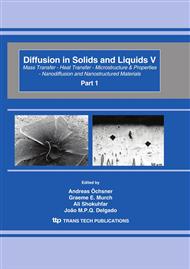p.790
p.796
p.802
p.808
p.814
p.820
p.826
p.832
p.838
A Study of Porosity Influence on Thermal Diffusivity of Aluminium Foam by Experimental Analysis and Numerical Simulation
Abstract:
Aluminium foam is a unique material possessing very high thermal diffusivity due to high thermal conductivity of the cell walls accompanied with rather low overall thermal conductivity, controlled via porosity [1]. There is a presumption of increasing influence at thermal diffusivity of aluminium foam by decreasing porosity, following the presented results (e.g. by using the transient plane source method [2]) and relation between thermal diffusivity and density. Thermal diffusivity of aluminium foam considering various porosity and various compositions of precursors were observed. The Aluminium foam was prepared by the powder metallurgy route, also well known as the ALULIGHT process, and various densities were achieved by changing of parameters (temperature, time) of foaming. The following types of foamable precursors were used: AlMg1Si0.6, AlSi10, as blowing agent was used 0.8 wt. % of TiH2.The thermal diffusivity of particular precursors by the flash method was measured. Specific heat capacities of samples with different density were measured by a calorimeter for various temperatures. The coefficient of thermal conductivity as a function of temperature was calculated by heat transient experiment data and numerical simulation consequently as an inverse heat transfer task. The problem was solved by the finite element method using the engineering-scientific program code ANSYS. The results depend on the thermal diffusivity, on the porosity and the type of precursor. Despite that aluminium foam is considered as a type of composite, thermophysical properties could be calculated upon known volume of aluminium alloy and air in the pores However there is a presumption that this rule cannot be used in case of porous materials. Values obtained by the mentioned methodology shown a significant influence on the porosity and the thermal diffusivity of the aluminium foam.
Info:
Periodical:
Pages:
814-819
Citation:
Online since:
April 2010
Authors:
Price:
Сopyright:
© 2010 Trans Tech Publications Ltd. All Rights Reserved
Share:
Citation:


